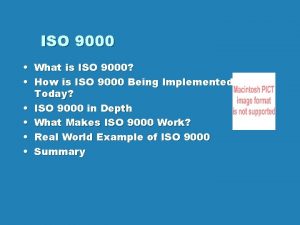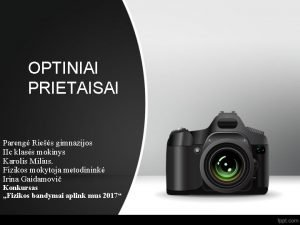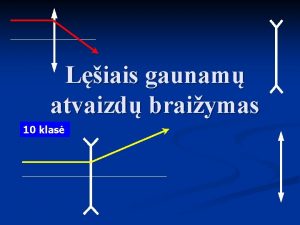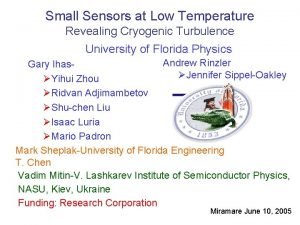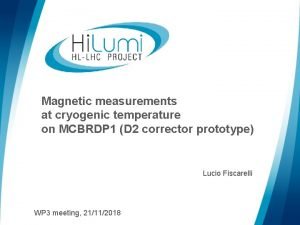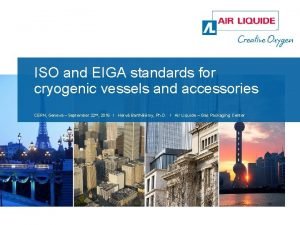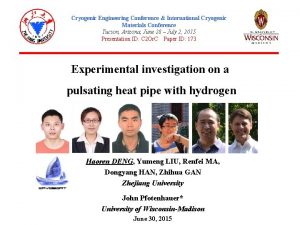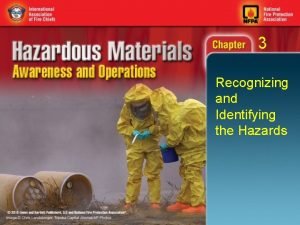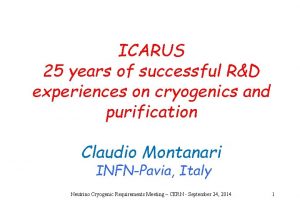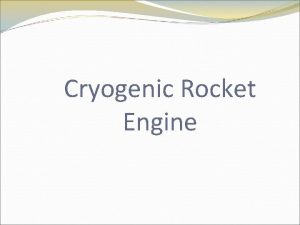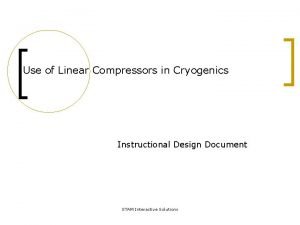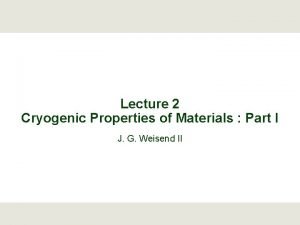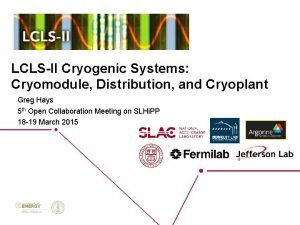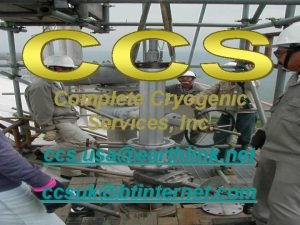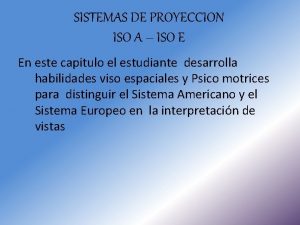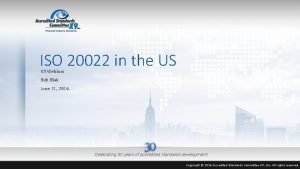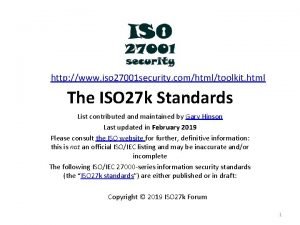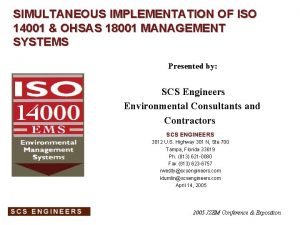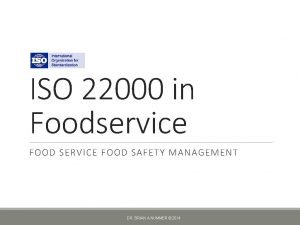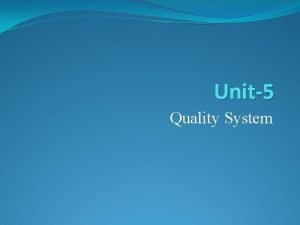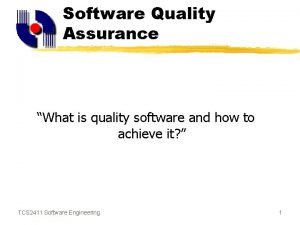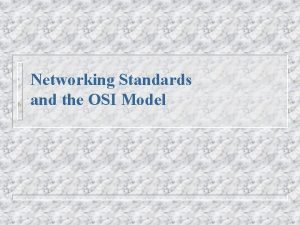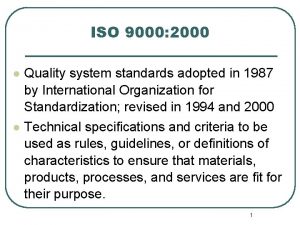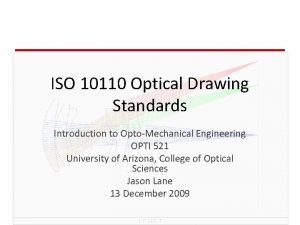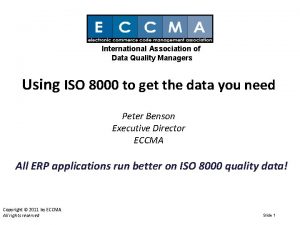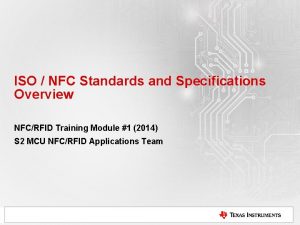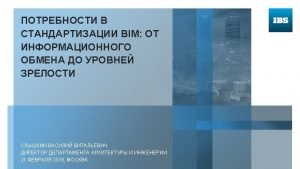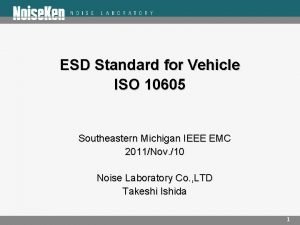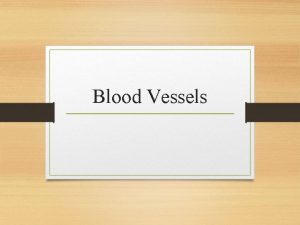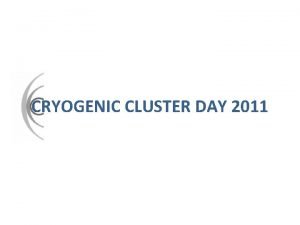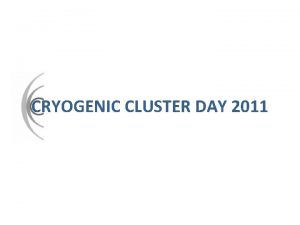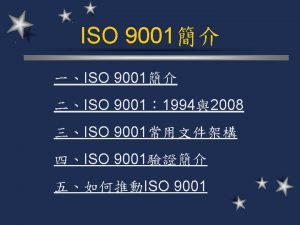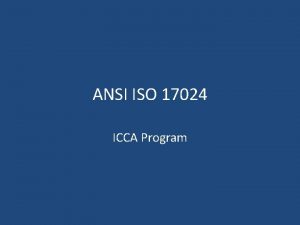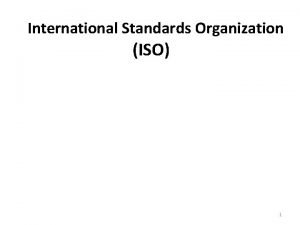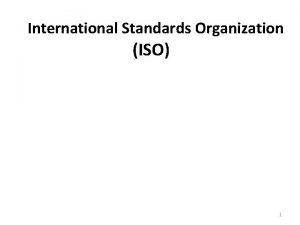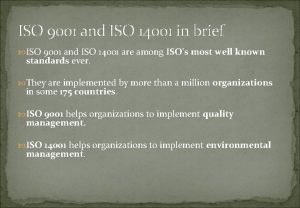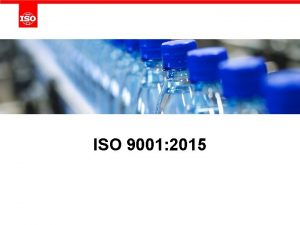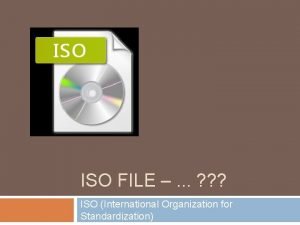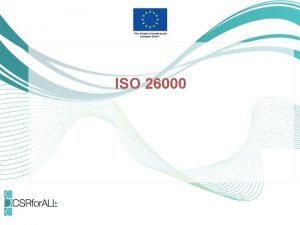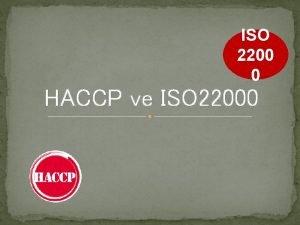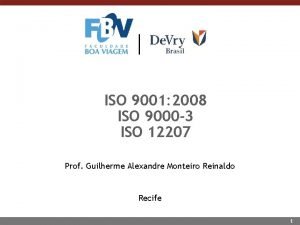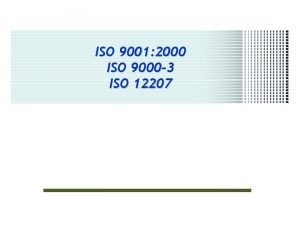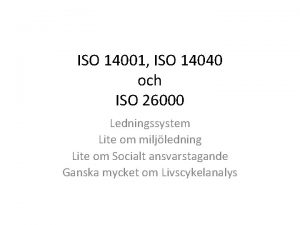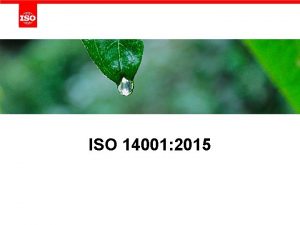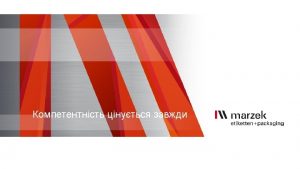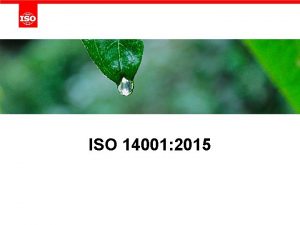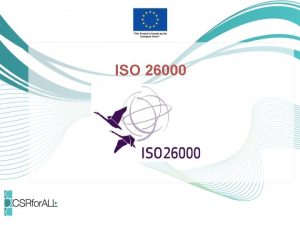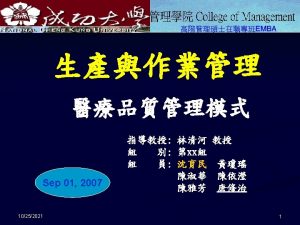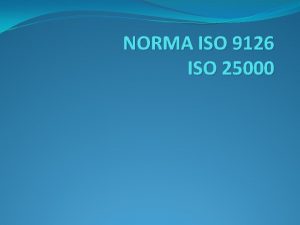ISO and EIGA standards for cryogenic vessels and




































- Slides: 36

ISO and EIGA standards for cryogenic vessels and accessories CERN, Geneva – September 22 nd, 2016 l Hervé Barthélémy, Ph. D. l Air Liquide – Gas Packaging Center

Contents q. Introduction q. Material issues q. Cold stretching q. Legislative and normative frameworks q. European Industrial Gases Association q. ISO/TC 220 – Cryogenic Vessels q. Future work at ISO/TC 220 2 Date Doc title World leader in gases, technologies and services for Industry and Health

Introduction q Different types of cryogenic vessels: üVacuum insulated / non-vacuum insulated üStatic / transportable 3 September 2016 H. Barthélémy World leader in gases, technologies and services for Industry and Health

Introduction q Used for more than 40 years for the storage and transportation of industrial and medical gases üIn a volume of 1 L of liquid, about 800 L of gas can be stored X The gases need to be refrigerated down to very low temperatures to be in liquid form Gases CO 2 Kr O 2 Ar Air N 2 Ne H 2 He Boiling temperatures (°C) -78. 5 -153 -186 -191 -196 -246 -253 -269 Boiling temperatures at atmospheric pressure of different gases Necessary to use high efficiency vacuum insulated vessels 4 September 2016 H. Barthélémy World leader in gases, technologies and services for Industry and Health

Material issues q. Materials issues (e. g for liquid hydrogen) ØHydrogen embrittlement (-150°C) - Warm (vessel almost empty) ØCompatibility of metals and alloys with low temperatures, in particular: üBrittleness üThermal conduction üExpansion and contraction phenomena üCondensation of liquid air in the interspace (50/50 O 2 -N 2) 5 September 2016 H. Barthélémy World leader in gases, technologies and services for Industry and Health

Material issues q. Metallic materials commonly used Source: ISO 21010 « Cryogenic vessels » - Gas/materials compatibility 6 September 2016 H. Barthélémy World leader in gases, technologies and services for Industry and Health

Cold stretching q Reducing the wall thickness of the vessels -> cold stretching Stress/strain curve for carbon steel Stress/strain curve for austenitic stainless steel Permanent plastic deformation Improvement of the yield strength Reduction of the wall thickness (weight, cost) 7 September 2016 H. Barthélémy World leader in gases, technologies and services for Industry and Health

Legislative and normative frameworks Regional International PED, TPED UN Standard CEN ISO Industry EIGA, CGA IOMA Legislative 8 September 2016 H. Barthélémy World leader in gases, technologies and services for Industry and Health

European Industrial Gases Association q European and a number of non-European companies producing and distributing industrial, medical and food gases. q EIGA/WG-6: Cryogenic Vessels (& accessories) Design, material compatibility, operational requirements and periodical inspection üTo monitor international standardisation (ISO, CEN) and regulations (UN, TPED, PED) to prepare Codes of Practice or guidelines üTo review accidents and incidents, to determine the causes and to propose ways to avoid re-occurrence ü 12 documents (incl. 4 harmonized with CGA) 9 September 2016 H. Barthélémy World leader in gases, technologies and services for Industry and Health

EIGA documents www. eiga. eu Doc. n° Title Applies to H 2, He? Doc. 06/02 Safety in storage, handling and distribution of liquid hydrogen H 2 Doc. 07/14 Metering of Cryogenic Liquids Doc. 24/08 Vacuum insulated cryogenic storage tank systems pressure protection devices Doc. 114/09 Operation of static cryogenic vessels Doc. 115/12 Storage of Cryogenic Air Gases at User’s Premises Doc. 119/04 Periodic inspection of static cryogenic vessels H 2, He Doc. 151/15 Prevention of Excessive Pressure during Filling of Cryogenic Vessels H 2, He Doc. 159/14 Reciprocating Cryogenic Pumps and Pump Installations Doc. 164/10 Safe handling of liquid carbon dioxide containers that have lost pressure Doc. 168/11 Calculation Method for analysis and prevention of overpressure during Refilling of Cryogenic Tanks with Rupture Disks PP 09/09 Rev 1 The Pressure Equipment Directive. Periodic Inspection and Reassessment of static Cryogenic Vessels for use in the European union H 2, He TB 11/14 Recommendations for the Prevention of Brittle failure of the Outer Jacket of Vacuum Insulated Cryogenic Storage Tanks H 2, He 10 September 2016 H. Barthélémy World leader in gases, technologies and services for Industry and Health H 2, He

European Industrial Gases Association q Doc. 06/02 - Safety in storage, handling and distribution of liquid hydrogen Ø Guidance of companies for the installation of liquid hydrogen storage at the user's premises and the distribution of liquid hydrogen by road, rail and sea transport. A liquid hydrogen storage installation on a user's premises is defined. It applies to the layout, design and operation of such fixed storages and the transportation of liquid hydrogen in bulk form by tankers or tank containers, by road, sea and rail, to fixed storages at user's premises. Portable containers, such as pallet tanks and liquid cylinders, are excluded from the scope of this document. 11 September 2016 H. Barthélémy World leader in gases, technologies and services for Industry and Health

European Industrial Gases Association q Doc. 114/09 - Operation of static cryogenic vessels Ø Specifies the procedures for putting into service, inspections, requalification according to the PED, taking out of service, maintenance and repair of static cryogenic vessels designed for a maximum allowable pressure of more than 0. 5 barg. Describes the operation of static cryogenic vessels, putting into service, inspections, taking out of service, maintenance and repairs and includes: • How the user operates the vessel • How local authorities and competent persons inspect these vessels to get common agreement about the operation that allows free movement within Europe without additional approvals 12 September 2016 H. Barthélémy World leader in gases, technologies and services for Industry and Health

European Industrial Gases Association q Doc. 119/04 - Periodic inspection of static cryogenic vessels Ø Periodic inspection and testing of static vacuum insulated cryogenic pressure vessels used in the storage of refrigerated liquefied gases, excluding toxic gases. The PED only covers design, manufacturing and placing on the market. The national legislations and practices for periodic inspection and testing varies considerably between European countries (even for similar vessels on similar services) q Doc. 151/15 - Prevention of Excessive Pressure during Filling of Cryogenic Vessels Ø Guidance for the filler/owner of either transportable or static cryogenic tanks, detailing the systems and procedures that can be used to prevent them being over pressurized during filling. To address the issue of receiving vessels greater than 1000 L water capacity. Also used for receiving vessels under 1000 L that are not designed for transport when full. Guidance for other products and other transfer systems. 13 September 2016 H. Barthélémy World leader in gases, technologies and services for Industry and Health

European Industrial Gases Association q TB. 11/114 – Recommendations for the prevention of Brittle Failure of the Outer Jacket of Vacuum Insulated Cryogenic Storage tanks Risks to consider : Ø Hidden failure due to differential thermal expansions within piping Ø Brittle fracture due to imingment of cryogenic fluids onto the outer jacket q PP 09/09 – The PED – Periodic Inspection and Reassessment of Static Cryogenic Vessels for use in the EU Ø The conditions for the periodic inspections are very different from member state to member state of the EU ØNo mutual recognition of the periodic inspection performed in another country The PP gave the future action to be considered at the European level. 14 September 2016 H. Barthélémy World leader in gases, technologies and services for Industry and Health

ISO/TC 220 – Cryogenic Vessels q ISO/TC 220: Cryogenic Vessels Standardization in the field of insulated vessels (vacuum or non-vacuum) for the storage and the transport of refrigerated liquefied gases of class 2 of "Recommendations on the Transport of Dangerous Goods - Model regulations - of the United Nations", in particular concerning: üthe design of the vessels üthe operational requirements of the equipment and accessories üthe supporting standards (safety accessories, gas/materials compatibility, insulation performance…) 15 September 2016 H. Barthélémy World leader in gases, technologies and services for Industry and Health

ISO/TC 220 - Structure ISO/TC 220 Cryogenic vessels WG 1 Design and construction Secretariat : AFNOR Convenor: HB WG 2 Operational requirements Secretariat : DIN Secretariat : AFNOR Chairperson: HB WG 3 Supporting standards Secretariat : CGA/ANSI 20 published ISO standards under the direct responsibility of ISO/TC 220 16 September 2016 H. Barthélémy World leader in gases, technologies and services for Industry and Health

ISO/TC 220 - Standards Large transportable vacuuminsulated vessels ISO 20421 series Transportable vacuum-insulated vessels ≤ 1000 L ISO 21029 series Valves ISO 21011 Hoses ISO 21012 Gas/materials compatibility ISO 21010 Insulation ISO 21014 17 September 2016 H. Barthélémy Static vacuum-insulated vessels ISO 21009 series Pressure relief accessories ISO 21013 series Pumps ISO 24490 Vessels Accessories Toughness requirements for materials ISO 21028 series Cleanliness for cryogenic service ISO 23208 World leader in gases, technologies and services for Industry and Health

ISO/TC 220 – Standards for cryogenic vessels q ISO 20421 series – Large transportable vacuum insulated vessels Ø Part 1: Design, fabrication, inspection and testing • Volume > 450 L • Does not apply to toxic fluids • Permanently (fixed tanks) or not permanently (demountable tanks and portable tanks) attached to a means of transport, for one or several Ø Part 2: Operational requirements • Putting into service • Filling, withdrawal • Transport within the location, storage • Maintenance, periodic inspection • Emergency procedures 18 September 2016 H. Barthélémy q ISO 21029 series – Transportable vacuum insulated vessels Ø Part 1: Design, fabrication, inspection and testing • Volume ≤ 1000 L • Does not apply to toxic fluids • Permanently (fixed tanks) or not permanently (demountable tanks and portable tanks) attached to a means of transport, for one or several Ø Part 2: Operational requirements • Putting into service • Filling, withdrawal • Transport within the location, storage • Maintenance, periodic inspection • Emergency procedures World leader in gases, technologies and services for Industry and Health

ISO/TC 220 – Standards for cryogenic vessels q ISO 21009 series – Static vacuum insulated vessels Ø Part 1: Design, fabrication, inspection and testing Ø Part 2: Operational requirements • Installation • Putting into service • Filling, withdrawal • Transport within the location, storage • Maintenance, periodic inspection • Emergency procedures 19 September 2016 H. Barthélémy World leader in gases, technologies and services for Industry and Health

ISO/TC 220 – Standards for accessories q ISO 21011 – Valves q ISO 24490 – Pumps • Design • Manufacture • Testing For a rated temperature of -40°C and below q ISO 21012 – Hoses • Design • Manufacture • Testing • Marking requirements For a working temperature of 270°C to -65°C Nominal size (DN) from 10 to 100 q ISO 21013 series – Pressure-relief accessories • Design • Manufacture • Testing • Marking requirements Part 1: Reclosable pressure-relief valves Part 2: Non-reclosable pressure-relief devices (bursting disc, buckling pin) Part 4: Pressure-relief accessories Part 3: Sizing and capacity determination -> calculation methods for determining the required mass flow to be relieved depending on specified conditions 20 September 2016 H. Barthélémy World leader in gases, technologies and services for Industry and Health

ISO/TC 220 – Standards for accessories q ISO 21010 – Gas/materials compatibility • Compatibility requirements (e. g. chemical resistance) • Detailed compatibility requirements for oxygen and oxygen-enriched atmospheres q ISO 21028 series – Toughness requirements for materials at cryogenic temperature • Part 1: Temperatures below -80 degrees C • Part 2: Temperatures between -80 degrees C and -20 degrees C q ISO 21014 – Insulation performance • Practical methods for determining the heat-leak performance of cryogenic vessels q ISO 23208 – Cleanliness for cryogenic service • Acceptable level of surface and particle contamination to minimize the risk of malfunction of equipment ans ensure safety against ignition when in contact with oxygen or oxidizing fluids 21 September 2016 H. Barthélémy World leader in gases, technologies and services for Industry and Health

Future work at ISO/TC 220 q. Systematic revisions of the published standards (every 5 years) q. New standard for the safety of liquid helium cryostats 22 September 2016 H. Barthélémy World leader in gases, technologies and services for Industry and Health

End of presentation Thank you for your attention

Back up slides

The application of the PED on the design codes for cryogenic equipment and future developments foreseen in this field Paris, 06/09/2016 l Hervé BARTHELEMY Ph. D. , Jean-Luc FOURNEL, Lucien VARASSI l AIR LIQUIDE

Summary ■ Background ■ PED – Advantages for the Industry ■ PED – Inconvenients for the Industry ■ PED – Main changes compared to national regulations ■ PED – Notified Body ■ PED – Category and module ■ PED – EN and ISO Standards published for pressure vessels ■ PED – Requalification of national design vessels when possible 26 Date Doc title World leader in gases, technologies and services for Industry and Health

Background q PED: Pressure Equipment Directive q. First version published in 1997 q First revision in 2014. Ø PED covers Static Pressure Equipment Ø Some cylinders are also covered by PED Ø PED only covers design, manufacturing and firstplacing on the market Ø PED is mandatory in European union since end of May 2002 27 Date Doc title World leader in gases, technologies and services for Industry and Health

PED – Advantages for the Industry q Same design can be used in all European Union countries Allows manufacturers to optimize design and to reduce manufacturing cost q Approval from only one notified body is necessary Allows to obtain better conditions from notified Bodies Allows to “open” difficult markets/countries q Should allow a company to harmonise PE fleet in European Union Not always possible because of different practices in the different countries e. g. different service pressures or safety accessories q Also recognized in Eastern European countries 28 Date Doc title World leader in gases, technologies and services for Industry and Health

PED – Inconvenients for the Industry q Sometimes more stringent than old national codes § For materials § For safety accessories § Vaporisers are considered as pressure vessels q May lead to cost increase 29 Date Doc title World leader in gases, technologies and services for Industry and Health

PED – Main changes compared to national regulations q All vessels > 0, 5 bar are subjected q Pressure test (coefficient: 1, 43) q Pipes > DN 25 to be PED compliant q The entire control cabinet (with accessories > DN 25) to be PED compliant q Risk analysis to be submitted to the Notified Body q Choice of a Notified Body per product line 30 Date Doc title World leader in gases, technologies and services for Industry and Health

PED – Notified Body q PED allows the cryogenic vessel manufacturer to choose a unique Notified Body as per the following criteria: ü Qualification and capability ü Wide recognition, even outside the European borders ü Close collaboration ü Competitiveness 31 Date Doc title World leader in gases, technologies and services for Industry and Health

PED – Category and module q For cryogenic vessel for LIN, LOX and LAR § Risk category IV § Module G (unit CE approval) § Or Modules B + D Ø CE type approval Ø Production quality assurance 32 Date Doc title World leader in gases, technologies and services for Industry and Health

PED – EN and ISO standards published for pressure vessels q Vessels ISO reference EN reference Title EN ISO 21009 -1* EN 13458 -1 Static vacuum insulated vessels Part 1(ISO and EN): Fundamental requirements EN ISO 21009 -1* EN 13458 -2 Static vacuum insulated vessels Part 1(ISO) Part 2(EN): Design, fabrication, inspection and tests EN ISO 21009 -2 EN 13458 -3 Static vacuum insulated vessels Part 2(ISO) Part 3(EN): Operational requirements EN 14197 -1 Static non-vacuum insulated vessels Part 1: Fundamental requirements EN 14197 -2 Static non-vacuum insulated vessels Part 2: Design, fabrication, inspection and tests EN 14197 -3 Static non-vacuum insulated vessels Part 3: Operational requirements * Under revision 33 Date Doc title World leader in gases, technologies and services for Industry and Health Static vacuum insulated vessels Static nonvacuum insulated vessels

PED – EN and ISO standards published for pressure vessels q Accessories ISO reference EN reference Title ISO 21011* EN 1626 Valves for cryogenic services EN ISO 21012* EN 12434 Hoses ISO 21013 -1* EN 13648 -1 Pressure relief devices Part 1: Reclosable pressure-relief devices ISO 21013 -2* EN 13648 -2 Pressure relief devices Part 2: Non-reclosable pressure-relief devices ISO 21013 -3* EN 13648 -3 Pressure relief devices Part 3: Sizing and capacity determination ISO 21013 -4* EN ISO 24490* Pressure relief devices Part 4: Pilot operated pressure-relief EN 13275 Pumps for cryogenic vessels * Under revision 34 Date Doc title World leader in gases, technologies and services for Industry and Health

PED – EN and ISO standards published for pressure vessels q Materials ISO reference EN reference Title ISO 21010* EN 1797 Gas/materials compatibility EN ISO 21028 -1* EN 1252 -1 Toughness requirements for materials at cryogenic temperature Part 1: Temperature below -80°C EN ISO 21028 -2* EN 1252 -2 Toughness requirements for materials at cryogenic temperature Part 2: Temperature between -80°C and -20°C ISO reference EN reference Title ISO 21014* EN 12213 Cryogenic insulation performance ISO 23208* EN 12300 Cleanliness for cryogenic service q Miscellaneous * Under revision 35 Date Doc title World leader in gases, technologies and services for Industry and Health

PED – Requalification of national design vessels when possible q To re-qualify cryogenic vessels, original documents of design and manufacturing must be presented to the Notified Body q. Cryogenic vessels are generally built according to different national construction code: § French code § German code § Belgian code § Dutch code q Documents to be supplied: § Drawing of approval § Annex to the drawing of approval § § 36 (device’s description) Calculation of internal bowl Certificate of hydraulic test (event) Date Doc title § Operating modes of soldering § Qualifications of the welders § Report of the radiographic § examinations X-ray World leader in gases, technologies and services for Industry and Health
 Used il acl 9000
Used il acl 9000 Optiniai prietaisai
Optiniai prietaisai Gaunam
Gaunam Cryogenic temperature
Cryogenic temperature Cryogenic temperature
Cryogenic temperature Cold stretching cryogenic vessel
Cold stretching cryogenic vessel International cryogenic materials conference
International cryogenic materials conference Mc 338
Mc 338 Cryogenic research icarus
Cryogenic research icarus Cryogenic rocket meaning
Cryogenic rocket meaning Independence cryogenic engineering
Independence cryogenic engineering Cryogenic materials data handbook
Cryogenic materials data handbook Cryogenic transferlines
Cryogenic transferlines Cryogenic instrumentation
Cryogenic instrumentation Complete cryogenic services
Complete cryogenic services Customer service standards table
Customer service standards table Simbolo de iso e
Simbolo de iso e Iso 8583 to iso 20022 mapping
Iso 8583 to iso 20022 mapping Iso 27550
Iso 27550 Iso 9001 iso 14001 ohsas 18001 comparison
Iso 9001 iso 14001 ohsas 18001 comparison What is the objective of iso 22000? *
What is the objective of iso 22000? * Iso 9000 standards
Iso 9000 standards Iso 9001 software quality assurance
Iso 9001 software quality assurance Iso networking standards
Iso networking standards Iso 9000 standards
Iso 9000 standards Iso 9001 drawing standards
Iso 9001 drawing standards Data quality standards iso
Data quality standards iso Nfc iso standards
Nfc iso standards Bim iso standards
Bim iso standards Iso 10605 esd
Iso 10605 esd Kontinuitetshantering i praktiken
Kontinuitetshantering i praktiken Typiska drag för en novell
Typiska drag för en novell Tack för att ni lyssnade bild
Tack för att ni lyssnade bild Ekologiskt fotavtryck
Ekologiskt fotavtryck Varför kallas perioden 1918-1939 för mellankrigstiden?
Varför kallas perioden 1918-1939 för mellankrigstiden? En lathund för arbete med kontinuitetshantering
En lathund för arbete med kontinuitetshantering Adressändring ideell förening
Adressändring ideell förening
